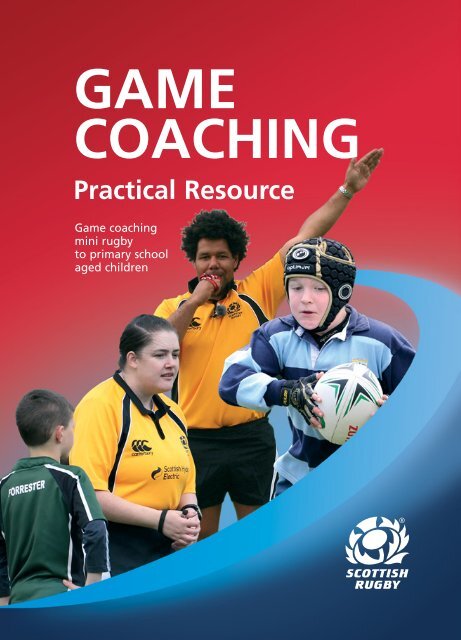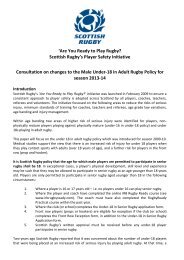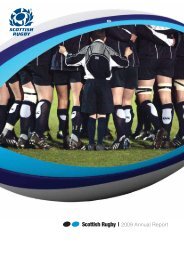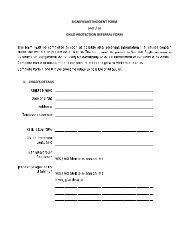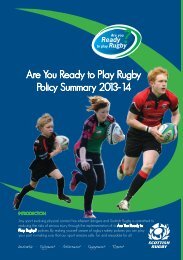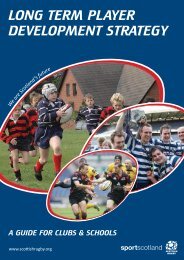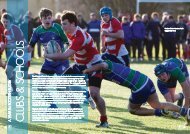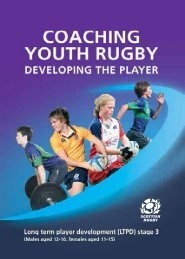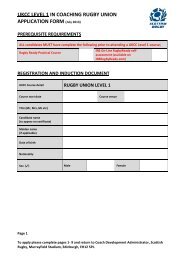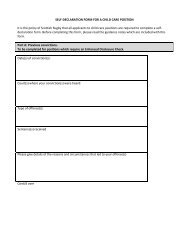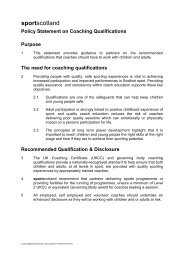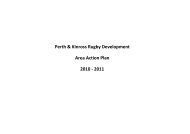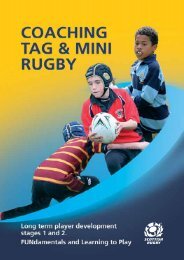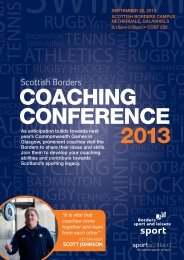You also want an ePaper? Increase the reach of your titles
YUMPU automatically turns print PDFs into web optimized ePapers that Google loves.
GAMECOACHINGPractical Resource<strong>Game</strong> <strong>coaching</strong>mini rugbyto primary schoolaged children
Contents1 Introduction to game <strong>coaching</strong>42 General principles of game <strong>coaching</strong>72a2b2c2d2e2f2gSafetyPlayer and game managementTechnical and tactical information transferFault correction and player feedbackEqualityApplication of LawsKnowledge, skills and attributes of a good game coach7810131414153 Development areas and <strong>coaching</strong> through games164 Communication and effective use of advantage185 <strong>Game</strong> <strong>coaching</strong> during open play and dealing with offside226 How to game coach the ...256a6b6c6d6eTap and passScrumLineoutTackleRuck and maul25273134367 Dealing with conflict and abuse383
1Introduction to game <strong>coaching</strong>This resource provides guidance on all aspects of game <strong>coaching</strong> forcoaches, teachers, match officials and parents who are involved in theprovision of mini rugby to primary school aged children (5-12 years). It willhelp game coaches to perform their role, by offering guidance in thefollowing areas:<strong>coaching</strong> players as the game is being played;encouraging best practice;correcting poor practice;providing feedback;ensuring players respect the laws and officials;allowing the game to flow with fewer stoppages;. build the confidence of players in an enjoyable and challengingenvironment.Aim of game <strong>coaching</strong>: The difference between managing game activityagainst <strong>coaching</strong> through a game“During the early stages of participation, with an emphasis on playfulactivities, the coaches’ role is mainly to act as a ‘resource person’ who canmodify the environment or supply directive feedback and instructions inorder to quickly correct errors” (Ian Stafford, <strong>coaching</strong> children in sport,2011, Routledge).Playing rugby games and modified training games are very useful to helpplayers to develop both their skills and game understanding. To ensurethat all players at all levels are improving, coaches should ensure that theyactively coach through the game rather than just managing the activity.This means providing specific feedback on technical (e.g. tackle technique)and tactical (player and game movement) aspects of the game throughpraise of good practice, <strong>coaching</strong> points, checking understanding throughopen questioning and an accurate <strong>coaching</strong> focus (not trying to fixeverything at once). Combining these methods will improve thedevelopment of the players in a fun and challenging environment.4
“Children love discovering, inventing and having fun - all at the sametime - in a stimulating environment. They should not, however, beallowed to work in the comfort zone as it bores them very quickly andhinders progress.” (Jeremie Spencer, Introduction of <strong>Rugby</strong> to Children InFrance, 2004, <strong>Rugby</strong> Football <strong>Union</strong> & Jeremie Spencer).Using these ‘game <strong>coaching</strong>’ skills will help you create an effectivelearning environment which is FUN and exciting, enabling you todevelop players of all levels and ability and hopefully retain yourplayers as a result.There should only ever be one game coach on the field at all times andno other adults on the field of play. This allows every player to makedecisions for themselves based on their playing experiences as well astaking away the distraction of multiple coaches constantly sending mixedmessages.5
Recommended QualificationsFUNdamentals stage (5-9 years male, 5-8 years female)Minimum standard Recommended OtherEvery coach must Coaching should be Coaches shouldcomplete the mandatory delivered by a suitably also complete the<strong>Rugby</strong>Ready Practical qualified coach / IRB LawsCourse on a yearly basis teacher with a self-assessmentand IRB <strong>Rugby</strong>Ready UKCC <strong>Rugby</strong> <strong>Union</strong> each year -online assessment Level 1 qualification. available at(available atwww.irblaws.comwww.irbrugbyready.com).Learning to play (9-12 years male, 8-11 years female)Minimum standard Recommended OtherEvery coach must Coaching should be Coaches shouldcomplete the mandatory delivered by a suitably also complete the<strong>Rugby</strong>Ready Practical qualified coach / IRB LawsCourse on a yearly basis teacher with a self-assessmentand IRB <strong>Rugby</strong>Ready minimum UKCC <strong>Rugby</strong> each year -online assessment <strong>Union</strong> Level 1 available at(available at qualification as well as www.irblaws.comwww.irbrugbyready.com). <strong>Scottish</strong> <strong>Rugby</strong> / UKSCALevel 1 Strength andConditioningqualification.<strong>Scottish</strong> <strong>Rugby</strong> recommends coaches to attend appropriate workshops andother seminars to keep their <strong>coaching</strong> skills up to date. Continuousdevelopment for coaches can take many forms but in order to provide thebest <strong>coaching</strong> for young players, coaches should themselves aim to be thebest they can be. Coaches should contact their Club Coach Co-ordinatorfor details of appropriate workshops.6
General principles of game <strong>coaching</strong>2a SAFETYSafety is paramount to game <strong>coaching</strong> any rugby match. Nothing must beallowed to happen which is unsafe in any phase of the game. Safety musttake precedence over every other aspect of game <strong>coaching</strong>. Every activecoach, teacher and referee in clubs and school must attend the mandatory<strong>Rugby</strong>Ready practical course each year and complete the online IRB<strong>Rugby</strong>Ready online assessment.IF IT LOOKS DANGEROUS THEN STOP IT27
2b PLAYER AND GAME MANAGEMENTPlayer managementCommunicating effectively with players is a vital process skill for thegame coach to possess. It is important the game coach uses a two waycommunication process with listening and reading body language beingas important, if not more important, as talking and giving feedback.When communicating with younger players it is important that a gamecoach understands the needs of the players that he or she is workingwith, developing a real identification with the children. Jeremie SpencerC.T.D., F.F.R. notes in his paper ‘Introduction of <strong>Rugby</strong> to children inFrance’ when working with children, I try to develop a real identificationwith the children by using the following methods:1. Be aware of the magic space between the teacher and the child2. Try to use their language and their humour3. Always try to get down to their height to reassure them andattempt to de-dramatise what I am asking them to do4. The 5 C’s:. Competence: Ability to perform a task to a certain level i.e. social,cognitive, physical, technical and tactical competence. Confidence: An internal sense of overall positive self-worth andself-efficiency. Connection: Positive bonds with people and institutions resultingin successful relationships in family, school, club and community. Character and Caring: Respect for social and cultural rules,possession of standards for correct behaviours, a sense of right andwrong, and integrity. Creativity: Finding one’s own solutions.8
<strong>Game</strong> ManagementThe principles around managing a game of rugby union when game<strong>coaching</strong> are directly linked to the theory of invasion and evasiongames. These are team games in which the purpose is to invade theopponents’ territory (without getting caught) while scoring points andkeeping the opposing team’s points to a minimum, and all within acertain time period. Broken down to an even simpler definition this is<strong>coaching</strong> players to attack an area of space ‘where the opposition arenot’ and to defend areas where teams are attacking ‘where theattack is’.Looking at both of these areas in more depth, the main focus of thegame coach during attack should be on encouraging players to:maintain possession though continuity;avoid defenders by passing or dodging before contact;create space for other players (draw and pass); and. create space for themself (alignment, footwork before contact,early hand catch).Similarly, in defence, the game coach should focus on encouragingplayers to:. scan to see where the opposition are and then position themselvesaccordingly to defend the space;. move forward and make an effective tackle (beneath waist); and. compete for possession once the tackle has been completed.9
<strong>Scottish</strong> <strong>Rugby</strong>Principles of PlaymodelContestPossessionGo ForwardPressureCOMMUNICATIONSupportContinuity2c TECHNICAL AND TACTICAL INFORMATION TRANSFERKey <strong>coaching</strong> pointsPrior to the start of the game, the game coach should outline the aims ofthe activity as well as the key technical information that they will beworking on during the game.To maximise the learning of the players, the game coach shouldconstantly give accurate feedback to the players during the game. Thisshould take the form of vocal praise and correction such as:. “well done, good early hand catch with both hands”. “next time try to stretch with both hands and take the ball as earlyas you can”This will help the players to understand what they are doing well andwhat they need to do to improve.10
Correction of consistently occurring mistakesDuring the game, if mistakes occur consistently, the game coach shouldimplement the follow procedure to help develop players’ understandingand reinforce good practice.123Stop the gameThe game coach should blow the whistle and gather all players aroundso they can hear clearly.Highlight the mistake and openly question playersThe game coach should highlight the mistake in a way that doesn’tmake the players feel like they have done something wrong.When highlighting the mistake the game coach should use openquestions “Why do you think we keep dropping the ball?”“Can someone tell me what we should do before we catch the ball?” etc.This will engage the players and give the game coach a chance to see ifthe players understand what they are being asked to do. If the mistakesoccur because of a lack of effort the game coach should motivate theplayers in a constructive way.Reinforce <strong>coaching</strong> pointsThe game coach should finish the process by reinforcing the discussedlearning points with the players. This can be done by the use of openquestioning to check for understanding.Mini rugby should be simple. Invade the oppositions territory withoutgetting caught (evade). Players should be coached to attack an area ofspace, where the opposition aren’t and to defend areas where theopposition are attacking.During games of mini rugby the tendency is for the players to forgetabout the space on the pitch and to gather around the ball in an attemptto either get the ball or to tackle the player with the ball. As a result verylittle tactical development takes place.11
To help the players utilise the pitch and develop further tacticalunderstanding, the game coach should take the players through thefollowing steps to aid their understanding of space and how to useit correctly.12Stop the gameThe game coach should blow the whistle to stop the game. This can bedone even if there hasn’t been a natural stoppage in play if the playershave completely lost their shape and have gathered around the ball.Communicate to the players and use open questioningBy shouting “freeze and stand where you are” the game coach can getthe players to remain where they are so that more impact can be madewhen questioning the players on where they should be. This should befollowed by highlighting where the space is and where the playersshould be.With the use of effective open questions, the game coach can get theplayers to identify where they should be and where they should betrying to get the ball. “If all the players are here! Where is the spaceon the pitch?” “If the attackers are spaced out there! Where do weneed to defend?”12
2d FAULT CORRECTION AND PLAYER FEEDBACKTo help learning and development, the game coach should:. Set effort goals for the teams which will focus on aspects of thegame which is completely within the control of the players forinstance: “Work hard to find and attack space” (this will of courseimply accurate passing to move the ball to a player in space oreffective footwork and acceleration for the player directly attackingthe space);. progress and stretch goals to keep challenging the players accordingto their accomplishment of previously set effort goals - the challengeis ‘just right’ when players are successful 80% of the time;. use prompts and encouragement;. use specific praise to highlight good practice, so all players learnfrom the good examples;. use mistakes as learning points;. provide high levels of feedback and instruction at the correct timesto ensure that the game flows freely and is therefore more enjoyablefor all players;. reinforce through open questioning: “What was it that Johnny didreally well to allow you to attack the space and score the try?”;. try to keep feedback to no more than two or three keypoints; and. manage the game/training environment to achieve set effort goals.13
2e EQUALITYThe game coach must be fair, impartial and consistent at all times. Thiswill help create a positive learning environment which will reinforce thevalues of the game.2f APPLICATION OF LAWSIt is important that game coaches at all levels learn, understand and applythe laws in a consistent manner. Mini rugby law variations exist to providea safe and staged progressive learning environment.It is the responsibility of every player, coach, teacher, referee and gamecoach to know the laws of rugby union. <strong>Scottish</strong> <strong>Rugby</strong> encourages allinvolved to complete the IRB Laws assessment each year.www.irblaws.com<strong>Scottish</strong> <strong>Rugby</strong>’s age grade law variations can be downloaded from theAre You Ready to Play <strong>Rugby</strong>? pages of www.scottishrugby.org.14
2g KNOWLEDGE, SKILLS AND ATTRIBUTES OF A GOODGAME COACHA good game coach should be able to demonstrate the following:. knowledge and understanding of the full laws of the game;. knowledge, understanding and application of the Age Grade LawVariations, game <strong>coaching</strong> principles and the spirit and values ofthe game;. honesty, integrity and equality to both sides at all times(in matches and training);. an ability to educate players in the laws of the game whilst<strong>coaching</strong> the game;ability to teach the value of respect whilst <strong>coaching</strong> the game;. an ability to use advantage effectively ;. an ability to referee in accordance with player’s level ofexperience in a firm, sympathetic not domineering manner; and. an ability and desire to develop and build the confidence of allplayers within the squad, not just the talented players, ensuringenjoyment andlearning for everyone involved (including thegame coach).15
Development areas and <strong>coaching</strong>through games3Modified games are extremely useful to help players to develop theirskills and game understanding. Using modified games either prior to orbetween games can improve the players’ technical and tacticalunderstanding of certain areas of the game.Use of modified games and development areas will help the players tolearn more easily and take the potential need to win at all cost out of thesession. This in turn will help channel focus towards the process ofimproving and the resulting improved ability to compete.<strong>Game</strong> coaches should consider the following when <strong>coaching</strong> throughgames:What is the main objective / purpose for the practice?. What skills and tactics are the focus for development within thegame?. What modifications can be made to emphasise these skills andtactics?What will be the main problems for the player to solve?. What key questions can be asked to emphasise technical andtactical aspects?. What progressions and regressions can be made to ensurelearning for all?. How can I build the confidence of all the players on the pitch?For more information on development areas and <strong>coaching</strong> throughgames, game coaches should refer to <strong>Scottish</strong> <strong>Rugby</strong>’s <strong>coaching</strong> tag andmini rugby resource (LTPD stages 1 &2).16
Communication and effectiveuse of advantage4A game coach must be able to communicate effectively with players.This can be done in three ways.1. The VOICEThis is the most important tool that a game coach can use.. Clear vocal communication is vital if players are to understand whatthey can and cannot do. For example: “Red number two you joinedthe ruck in front of the hindmost player, you are offside. Penalty kickto blue. Next time make sure you come through the gate”. The voice can be used to help prevent offences taking place and toeffectively coach players through the game. Using phrases such as“keep two hands on the ball”; “stay onside”; “tackle below the waist”are helpful and maintain fluidity within the game. Praise and reinforcement of good practice is also a vital tool for thegame coach. This helps players to understand what they are doing aswell as giving a feeling of worth and contribution. Coaches should tryto remain specific when giving praise and reinforcement by telling theplayers what they are doing well and why e.g.: “well done; good passbecause you followed through to your target” and avoid simplyrepeating “good” or “well done”. The tone of the voice allows the game coach to demonstratesympathy or control depending on the situationBy using their voice effectively a game coach should enable the game toflow with fewer stoppages and be able to prevent foul play and errorsdue to a lack of effort which will lead to a better learning environmentfor the players.Prevention is better than the cure.18
2. The WHISTLE. Crowd noise and wind may impact on the effectiveness of your whistle.The whistle should be loud enough for all the players to hear andshould only be used to stop the game when necessary. The tone of the whistle should relate to thegame coach’s decision. For example, the toneof the whistle will vary between an accidentalinfringement (short) and a deliberate piece offoul play (long and loud).SHORTLONG3. BODY LANGUAGE and SIGNALS. It is not often ‘what we say’ that counts but ‘how we say it’ that ismore important. Use of eye contact with players will help them to listen and focus onwhat they are being told. <strong>Game</strong> coaches should try and smile and show the players that they areenjoying the game as wellBe serious when dealing with dangerous and foul play. A game coach should be aware of and use the five main refereeingsignals in mini rugby. (see below)TRY PENALTY FREE KICK SCRUM ADVANTAGE19
Effective use of advantage (Law 8)The purpose of the advantage law is to make phases of play morecontinuous with fewer stoppages for infringements. Players should beencouraged to play to the whistle despite any infringements that haveoccurred. The game coach should use their voice, as well as hand signalsto show that they have seen the infringement and that advantage isbeing played.Things to consider when playing advantage:. Advantage should never be played if there is any chance thatplayers are going to be put in danger. If an offence is spotted, the game coach’s first thought should be“can I play an advantage to keep the game flowing?”. There are two types of advantage that can be played:1. Tactical - an opportunity for the team to use the ball andpossibly score.2. Territorial - a gain in ground/field position. Advantage should not be played for too long especially if theball is trapped on the ground. If the same offences persistently occur, the game coach should notplay advantage and stop play to explain the nature of the offence. The game coach should communicate to the players thatadvantage is being played. This should be done by using theadvantage signal and calling “playing advantage” and should befollowed by a brief description of the offence “knock on blue”.If the game coach decides that there has been sufficientadvantage this should be communicated by calling “advantageis over” and cancelling their signal.20
StoppagesIf advantage has not occurred or dangerous play has taken place and it isnecessary to stop the game, the following sequence should take place:1. Whistle and correct signal simultaneously (style of which will depend oninfringement)2. Voice; positively explain to the players what the infringement was andthe resulting action, followed by a brief description of what they shouldbe doing in as short and clear a manner as possible.21
<strong>Game</strong> <strong>coaching</strong> during open playand dealing with offside5<strong>Game</strong> <strong>coaching</strong> during open playDuring open play the main role of the game coach is to facilitate positiveplay by reinforcing good practice as well as preventing offences / poorpractice before they happen. This should be done by praising players forwhat they are doing well for example, “great offload, you pushed yourhands free to pass”.Similarly if the game coach notices that a player is going to commit anoffence they can be given vocal instruction to hopefully prevent offencesbefore they commit them, “blue five you are offside, come back onside”.This can be supported with hand signals to help the player understandwhere they should be.22
Key points for open playPlayers should carry the ball in two hands at all times. This should helpgame coaches to promote the development of the following skills(evasion, passing and offloading for the ball carrier and individual tackletechnique for the tackler).By focusing on the development of these skills, the game should be freeflowingwith fewer stoppages, which will make the game more fun and abetter learning experience for all players.. During open play, if a player is carrying the ball in one hand thegame coach should use their voice to encourage the player to holdthe ball in two hands.. If the player consistently holds the ball in one hand (thereforelimiting the opportunities to develop the skills listed above) the gamecoach should stop play at a suitable opportunity.. Turn the stoppage into a learningopportunity, explaining why all playersshould have two hands on the ball andfinally check for understanding with allplayers.. If players continue to carry the ballin one hand, a tap and pass may beawarded.. The hand-off is not permitted whenplaying mini rugby. This is toencourage development of the skillsexplained above.23
Dealing with offsideIn general play a player is offside if the player is in front of a team-matewho is carrying the ball, or in front of team-mate who last played the ball.Offside stops the game flowing and should be prevented wheneverpossible.During open play, when a tackle has been made, a game coach can referto the ball as the offside line to all players. This will help to establish avisual aid for the players and will allow the game coach to manage theoffside.A game coach can effectively manage the offside situation using thefollowing process:. Preventative communication whilst the game is on-going.The game coach reminds all players to stay on their own side ofthe ball, this will hopefully stop the players infringing and allowplay to continue. If the offside play continues the game coach should:1. stop the game by blowing the whistle and ask the players tostand where they are;2. ask the player in possession of the ball to hold it where allplayers can see (above their head);3. by using open questions ask the infringing players where theythink they should be: “to get into an onside position which sideof the ball do you need to be on?”;4. prompt players to return to onside positions; and5. resume play when all players are onside by blowing the whistleand calling “play on”.If players continue to commit offside offences a penalty may be awardedand the game coach should ensure that all players understand why thepenalty has been awarded and are aware of where they should be toremain in an onside position, especially the player who has committed theoffence.24
6aHow to game coach the tap and passWhat is the order?TAP AND PASS1Where is the tap and pass?Tap and Pass restarts for all penalties should be taken from wherethe infringement happened.If a try is scored the Tap and Pass will take place in the middle ofthe pitch.. The game coach should show the players where to take the Tapand Pass by creating a mark in the turf with their boot.2Where do the players go during the Tap and Pass?. The team taking the Tap and Pass should start with the ball onthe mark awarded by the game coach or at the middle of thepitch after a try is scored.The defending team should be 5m back in a defensive line.. The game coach can help to set the distance by standing 5m fromthe mark on the defensive line.3What happens during the Tap?. The attacking team takes the Tap. This involves moving the ball avisible distance with the player’s foot (remember the tap isactually a tap kick and a kick must be performed to make theball live).. This can be done by placing the ball on the ground, tapping itwith the foot then picking it up. Alternatively, holding the ball intheir hands, the player can Tap the ball by performing a kick tothemselves.. If the Tap skill is not performed correctly the game coach shouldask for the Tap to be re-taken.25
What is the order?TAP AND PASS. The game coach should encourage different players to performthe Tap each time.4What happens after the Tap?Both teams should not move until the ball has left the firstplayer’s (player performing the Tap and Pass) hands.After the pass has been performed both teams should beencouraged to move forward.. The first receiver (player catching the Tap and Pass) does notneed to take the ball standing still and should practice movingonto the ball after it has been passed.. Once the first receiver has caught the ball they must passstraight away.5What commands should be given during the Tap and Pass?. The game coach should signal the Tap andPass with the correct hand signal and announcewhich team has been awarded the Tap andwhy: “free kick blue, red player offside”.. The game coach should remind allplayers that they are not to move untilthe ball has left the first player’s hands.. Both teams should be encouragedto move forward following thepass, this will help to foster anunderstanding of the principles ofplay i.e. go forward in attack anddefence.26
How to game coach the scrum6bWhichWhat is the order? SCRUM agegroup?123Where is the scrum?The scrum will be awarded at the place the stoppage orinfringement happened. This will be indicated to the playersby the game coach blowing the whistle, making the correcthand signal and explaining the reason why the scrum hasbeen awarded. The game coach will make a mark in the turfwith their foot; this will show the players where they are toset the scrum. The scrum must be at least 5m from the goaland touch lines.Who is in the scrum?The game coach will call the three players closest to the markto form the scrum. This will consist of two props and a hooker.The next closest player from each team will become the scrumhalf.The game coach will call the nearest three players closest tothe mark to form the front row, the next two players will becalled in to form the second rows with the sixth playerbecoming the scrum half.Where should the game coach stand?Initially the game coach should stand on the side of the scrumwhere the ball is being put in. The game coach should standbehind the scrum half, slightly to one side. This will allowobservation of the scrum as well as the scrum halves throw inof the ball down the middle. The exception to this would be ifthere had been a problem at the opposite side in the previousscrum.P6 &P7P6P7P6 &P727
WhichWhat is the order? SCRUM agegroup?4Coaching points and safety checksThe game coach should remind all players at every scrum thatthere is no pushing but both hookers are allowed to strike forthe ball once it is in the scrum.P6 &P7The game coach should check players for good body positionboth prior to and during engagement. During theengagement the game coach should look for:1. feet shoulder width apart, weight off heels and stay onthe balls of feet2. bend at the knees and hips3. keep head and shoulders above hips at all times4. feet, knees, hips and shoulders are square5. a straight flat back with spine in line with the directionof drive6. head in a neutral position7. firm and continuous bind to team-mate throughout8. props must bind on the opposition props back or side, witha straight arm parallel to the ground; the game coachshould correct any incorrect binding before the ball is putin. Second rows should bind on each other with their insidearm, then bind onto their props with their outside arm.Heads should be placed between the prop and hookerwith shoulders making contact on the back of the leg, atthe bottom of the rugby shorts.5<strong>Game</strong> coach commands during the engagement.The game coach should initiate the scrum using threecommands in a calm, even tone:“Crouch” and then “bind”. The front rows crouch and usingtheir outside arm, each prop must bind. A loosehead propmust bind on the opposing tighthead prop by placing the leftarm inside the right arm of the tighthead and gripping thetighthead prop’s jersey on the back or side. A tighthead propP6 &P728
WhichWhat is the order? SCRUM agegroup?must bind on the opposing loosehead prop by placing theright arm outside the left upper arm of the opposingloosehead prop and gripping the loosehead prop’s jerseywith the right hand only on the back or side.P6 &P7The props must not grip the opponent’s chest, arm, sleeve orcollar. Following a pause, the game coach will then call “set”when the front rows are ready. The front rows may thenengage.The “set” call is not a command but an indication that thefront rows may come together when ready.6What happens during the scrum?The non-offending team will have the throw in at the scrum.This will involve the scrum half throwing the ball through themiddle of the scrum (directly over the mark the game coachmade). The opposition scrum half should take up positionbeside their counterpart and remain here until the ball hasbeen passed from the scrum. All other players not involved inthe scrum must remain 5m behind the rear foot of the scrumuntil the ball has been passed.P6 &P77What happens after the scrum?Once the ball has emerged from the scrum, the scrum halfmust pass it. One further pass must be made before a try canbe scored. Once the ball has left the scrum, the players canleave the scrum.P6 &P729
How to game coach the lineout6cWhichWhat is the order? LINEOUT agegroup?1234Where is the lineout?a. The lineout is taken from where the ball crossed into touch.This can be where the ball itself crossed into touch or theplayer carrying the ball steps into touch. If the ball goes intotouch between the goal line and 5m line the lineout will formon the 5m line.b. When awarding the lineout the game coach should blowtheir whistle, make the appropriate signals and mark themiddle of the lineout with their foot on the touch line wherethe ball went out. This is where the hooker will throw the ballfrom. The start of the lineout should be marked by the gamecoach walking into the field three steps (3m), both teamsshould then set straight lines 1m apart.Who is in the lineout?All the forwards are in the lineout. One to throw the ball in(the hooker) with the other four forming the lineout, 3m fromthe touch line. The extra player on the defending team(defending hooker) stands near the front of the lineout butmust give space for the thrower to throw the ball in. All thebacks, excluding the scrum halves, must be back 5m.Where should the game coach stand?The game coach should stand at the front of the lineout butshould ensure that they can see all aspects stated above aswell as facing the defending team’s backs to make sure theystay 5m back until the ball emerges.Coaching pointThe game coach should ensure that only the attacking teammay compete for the ball. This must be done by the catchingplayer taking the ball above their head with both hands whilstP7 only(P4 - P6tap andpassfrommark)31
WhichWhat is the order? LINEOUT agegroup?5performing a two footed jump. If this is not possible due to apoor throw or weather conditions, the game coach may playadvantage or award a re-throw and bring the lineout closer tothe throwing player.What happens during the lineout?The ball is thrown down the middle of the lineout by theplayer performing the role of the hooker.Providing all the steps listed above have been completed thedefending team may contest possession when the attackingplayer lands to the ground.This may be done by performing a tackle or forming a maul.In mini rugby, this should be the only time that a maul isformed. If the throw is inaccurate and is caught by a memberof the defending team who has not contested possession, theymay be allowed to take the ball and play on.P7 only(P4 - P6tap andpassfrommark)6What happens after the lineout?If the ball is passed to the scrum half straight away, they mustpass. Similar to the scrum one more pass is required before atry can be scored. If the lineout is driven and a maul formed,the defending team may prevent the drive and contestpossession in a legal fashion. When the maul has stopped andthe ball has emerged, the scrum half has the choice to eitherrun or pass. Two passes from the lineout are still requiredbefore a try can be scored.32
How to game coach the tackleDefinitionTACKLE6d1Is the tackle legal?Tacklers must tackle below the waist and the ball must not be targetedi.e. the tackler must not grasp the ball or prevent the pass. If this occursthe game coach should be firm with the offending player and correctthe technique as stated above. This will allow increased opportunity forskill development and allow the game to flow. The game coach shouldbe firm in penalising illegal (above waist) and dangerous tackles (abovethe shoulder line or “spear” tackles).If a dangerous or illegal tackle is performed, the game should bestopped and the player made aware of the reason. If the tackle is abovethe waist and the advantage law rule may be applied, then the gamecoach can use their common sense, allowing the game to flow, butreminding the player using the voice to keep the tackles below thewaist.2What does the tackler do after the tackle?Once a tackle has been made, the game coach should encourage thetackler to release and move away from the tackled player. This willallow the tackled player to play the ball. If this situation is managedwell the game will flow better.3What does the tackled player do after the tackle?When the tackled player has been taken to ground they should beencouraged to pop the ball up to a support player if possible. This willhelp the continuity of the game and allow play to continue. If theoption of a pop pass is not possible, the game coach should encouragethe tackled player to present the ball back to their own team. If this isdone correctly it makes on - the - ground situations much easier tomanage as the ball is quickly back into play and fewer players caninterfere around the tackle area. This will allow the attacking team togain faster ball from the ruck, allowing them to continue play.34
DefinitionTACKLE4 What do the arriving players do?Arriving players must approach from their own side of the tackle i.e.with their backs to their own goal line.The game coach should watch out for arriving players not remaining ontheir feet and falling on top of the ruck.If this happens, blow immediately to stop the game to avoid injury andaward the penalty to the non-offending team.If the game coach is not sure who is at fault, the scrum (P6 and P7) ortap and pass (P4 and P5) should be awarded to the team goingforward.35
How to game coach theruck and maul6eDefinitionRUCK AND MAULDefinition of ruckA ruck is formed when the ball is on the ground and one or more playersfrom each team are on their feet and in physical contact, closing aroundthe ball. A ruck can be formed by two players, one from each side.Rucks are limited in mini rugby, since players are encouraged to pass theball out of the tackle. They do however occur, so the game coach must beaware of when and how a ruck is formed. The purpose of a ruck or maulis to recycle the ball after a tackle has been completed.Definition of maulA maul is formed by one or more players from each team on their feetand in physical contact closing around a player who is in possession of theball. A maul requires two players from the ball carrying side and onemember of the opposition.Mauls should not occur in open play if the game coach has correctlyapplied the tackle law. If a tackle is not completed, the game coachshould encourage the ball carrier to pass the ball, and prohibit defendersblocking the pass. In mini rugby, a maul should only occur at a lineout, asplayers are not allowed to target the ball in a tackle.36
DefinitionRUCK AND MAUL1 Arriving playersEnsure players stay on their feet - players who go to ground in thissituation are stopping the ball emerging quickly and causing a safetyconcern.Arriving players must enter the ruck through the “gate” from their ownteam’s side. This is an imaginary opening which is the width of theplayers who are on the ground.2If a maul collapses?Maul collapsed deliberately or accidentally. If the referee can identifyplayers who deliberately collapse a maul they should be penalised.If the maul collapses naturally without any infringement and the ball isimmediately available, the game should continue.3Will the ball emerge?In a ruck or maul the team in possession is responsible for continuity ofplay. If the ball does not emerge within five seconds the opposition isawarded a tap and pass. Before blowing the whistle, the referee shoulduse the phrase “use it or lose it” to encourage the side in possession toplay the ball. This should rarely happen as the defending team cannottarget the ball.4Where should the game coach stand?The game coach will gain benefit from being close to the formation ofthe ruck or maul but will get in the way if they remain there. Get thereand then move back a metre or two towards the touchline on the sidewhich is likely to win the ball.The game coach should position their body at 45 degrees facing thedefending side so that they can observe the overall situation.37
Dealing with conflict and abuseDealing with conflict7When dealing with foul play or player conflict the game coach should usea direct approach in a firm and calm manner and act quickly as it is ateachable moment. Where possible the game coach should caution theplayer/players rather than remove them from the field of play. If necessarythe game coach should ask the team coach to replace the offendingplayer giving them time to calm down and reflect on what they havedone. The game coach can use their discretion to allow the offendingplayer to return to the field of play but should always check that theyunderstand why they were removed from the field of play in the firstplace and have learned from the situation.Dealing with abuseIf game coach receives abuse from a team coach on the side-lines, thefollowing process should be followed:1 Stop the game.2. Approach the coach.3. Inform the coach in a calm and polite manner that if their poorbehaviour is not constructive for developing our young players andif the abuse continues they will be asked to leave the playing area.4. If the abuse continues, dismiss the coach from the playing area.5. If they refuse to leave, the game coach has no option but toabandon the game.The process above is challenging and therefore we need to set the scenewith clear behavioural guidelines for players, coaches andparents/spectators which are well communicated. The behaviour ofspectators and coaches is the responsibility of the home club andguidelines can be sent to visiting clubs before the event.38
If these guidelines are well communicated the above situation could behandled by simply referring to the guidelines and action accordingly.The Positive Coaching Scotland Programme in association with theBill McLaren Foundation aids in developing these guidelines specific toeach club.For more information on this accreditation programme please see:www.scottishrugby.org/clubs-schools/positive-<strong>coaching</strong>-scotlandprogramme39
Produced by <strong>Scottish</strong> <strong>Rugby</strong>Author - Andrew DouglasEdited by - Neil GrahamMany thanks to Jock Peggie for assistance with the production of this resource.www.scottishrugby.org.uk


